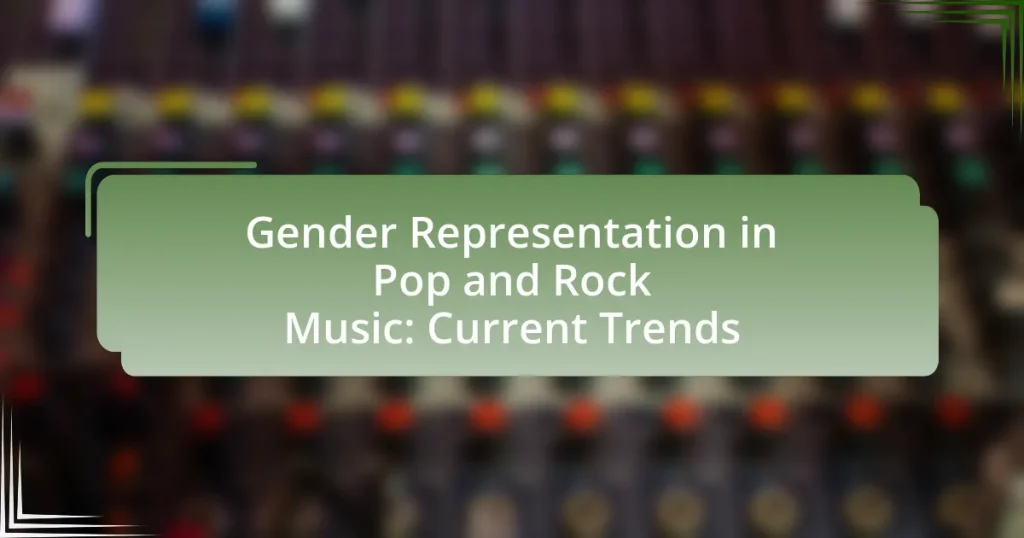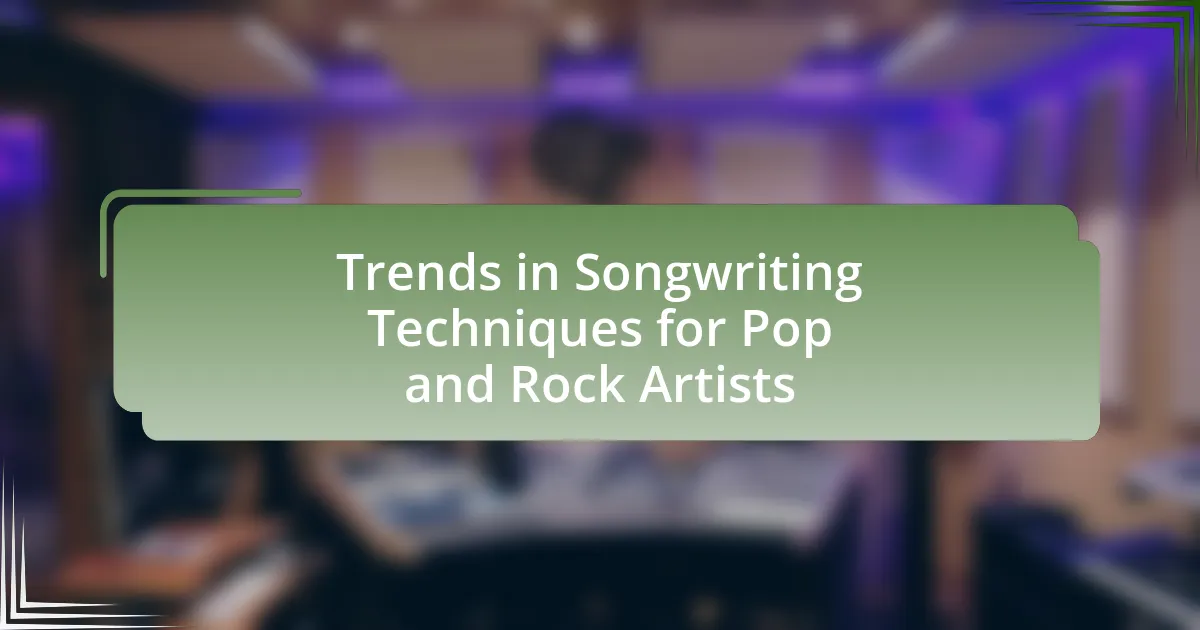Gender representation in pop and rock music examines the visibility and roles of different genders within these genres, revealing significant disparities in representation, influence, and recognition. Research indicates that women remain underrepresented, accounting for only 21% of artists on the Billboard Hot 100 in 2020, with historical trends showing a shift from male-dominated narratives to a more diverse portrayal of genders. The article explores the evolution of gender representation over time, highlighting key milestones, societal impacts, and current trends, while addressing the challenges and opportunities that exist for female and non-binary artists in the music industry today. It emphasizes the importance of gender representation in shaping cultural perceptions, promoting diversity, and influencing audience engagement within the music landscape.
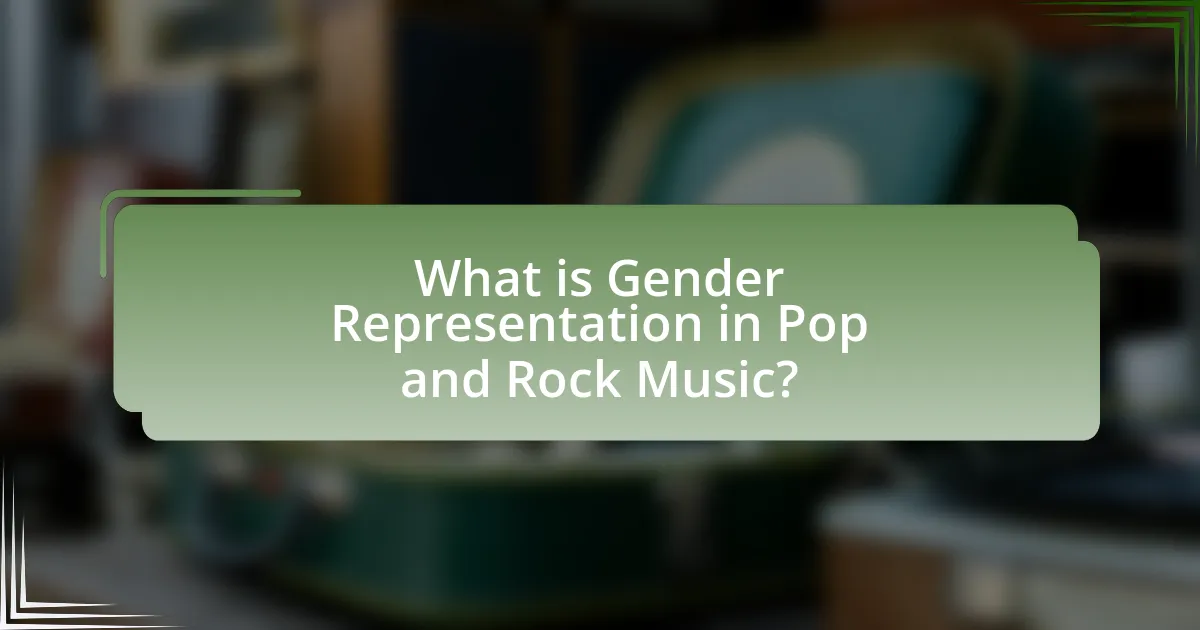
What is Gender Representation in Pop and Rock Music?
Gender representation in pop and rock music refers to the visibility and roles of different genders within these genres, highlighting disparities in representation, influence, and recognition. Research indicates that women are significantly underrepresented in both genres, with studies showing that female artists accounted for only 21% of the total artists on the Billboard Hot 100 in 2020. Additionally, a report by the Annenberg Inclusion Initiative found that only 12.3% of the top songs from 2012 to 2019 were performed by women. This lack of representation affects not only the artists themselves but also the narratives and themes prevalent in the music, often perpetuating stereotypes and limiting the diversity of voices in the industry.
How has gender representation evolved in these genres over time?
Gender representation in pop and rock music has evolved significantly over time, shifting from predominantly male-dominated narratives to a more balanced and diverse portrayal of genders. In the early decades of these genres, female artists were often relegated to stereotypical roles, such as the love interest or background performer, while male artists dominated the spotlight and creative control. For instance, in the 1960s and 1970s, iconic male figures like The Beatles and Led Zeppelin overshadowed female acts, who were often marketed based on their appearance rather than their musical talent.
However, the 1980s and 1990s saw a rise in female empowerment within these genres, exemplified by artists like Madonna and Janet Jackson, who challenged traditional gender roles and asserted their artistic identities. This shift was further supported by the emergence of feminist movements that advocated for women’s rights and representation in the music industry. By the 2000s, the landscape continued to change with the introduction of diverse voices, including LGBTQ+ artists and musicians from various cultural backgrounds, leading to a richer tapestry of gender representation.
Recent statistics indicate that women now account for approximately 30% of artists in the Billboard Hot 100, a notable increase from previous decades. Additionally, the rise of social media platforms has allowed female artists to gain visibility and control over their narratives, further contributing to the evolution of gender representation in pop and rock music. This ongoing transformation reflects broader societal changes regarding gender equality and representation, making these genres more inclusive than ever before.
What historical milestones have influenced gender representation in pop and rock music?
Historical milestones that have influenced gender representation in pop and rock music include the emergence of female artists in the 1960s, the feminist movements of the 1970s, and the rise of girl groups in the 1990s. The 1960s saw artists like Janis Joplin and Aretha Franklin break into male-dominated genres, challenging traditional gender roles. The feminist movements of the 1970s, exemplified by artists such as Joan Jett and the Riot Grrrl movement in the 1990s, further pushed for equality and representation, leading to a more diverse landscape in music. These milestones collectively contributed to the ongoing evolution of gender representation in the industry, as evidenced by the increasing visibility and success of female artists today.
How do societal changes impact gender representation in music?
Societal changes significantly impact gender representation in music by influencing the visibility and roles of female and non-binary artists. For instance, the rise of feminist movements and discussions around gender equality have led to increased support for women in music, resulting in a higher number of female artists achieving mainstream success. According to a 2021 report by the Annenberg Inclusion Initiative, women comprised only 21.6% of artists in popular music from 2012 to 2020, but this figure has been gradually improving as societal attitudes shift towards inclusivity. Additionally, the #MeToo movement has prompted a reevaluation of gender dynamics within the music industry, encouraging more equitable practices and representation. These societal shifts not only affect the artists themselves but also influence audience perceptions and industry standards, leading to a more diverse musical landscape.
Why is gender representation important in pop and rock music?
Gender representation is important in pop and rock music because it influences cultural perceptions and promotes diversity within the industry. When women and non-binary artists are visible and celebrated, it challenges traditional gender norms and provides role models for aspiring musicians. Research indicates that female representation in music can lead to increased participation of women in the industry; for instance, a study by the Annenberg Inclusion Initiative found that only 22.5% of artists in popular music were women from 2012 to 2019. This lack of representation can perpetuate stereotypes and limit the scope of artistic expression. Therefore, enhancing gender representation not only enriches the music landscape but also fosters a more inclusive environment that reflects the diversity of society.
What effects does gender representation have on audiences?
Gender representation significantly influences audience perceptions and behaviors. Research indicates that diverse gender representation in music can enhance relatability and emotional connection, leading to increased engagement among listeners. For instance, a study by the Geena Davis Institute on Gender in Media found that when women are portrayed in varied and empowered roles, audiences, particularly young girls, report higher self-esteem and ambition. Furthermore, gender representation shapes societal norms and expectations; when audiences see women and men in non-traditional roles, it can challenge stereotypes and promote gender equality. This effect is particularly pronounced in pop and rock music, where artists often serve as cultural icons, influencing public attitudes and behaviors.
How does gender representation influence the music industry?
Gender representation significantly influences the music industry by shaping artist visibility, audience engagement, and industry practices. For instance, studies show that female artists are often underrepresented in mainstream music charts, with only 22% of songs on the Billboard Hot 100 in 2020 featuring female artists, according to a report by the Annenberg Inclusion Initiative. This lack of representation can limit the diversity of musical expression and restrict opportunities for female musicians. Furthermore, gender representation affects the types of narratives and themes that are prevalent in music, as male-dominated perspectives often overshadow female voices. This imbalance can perpetuate stereotypes and influence societal perceptions of gender roles.
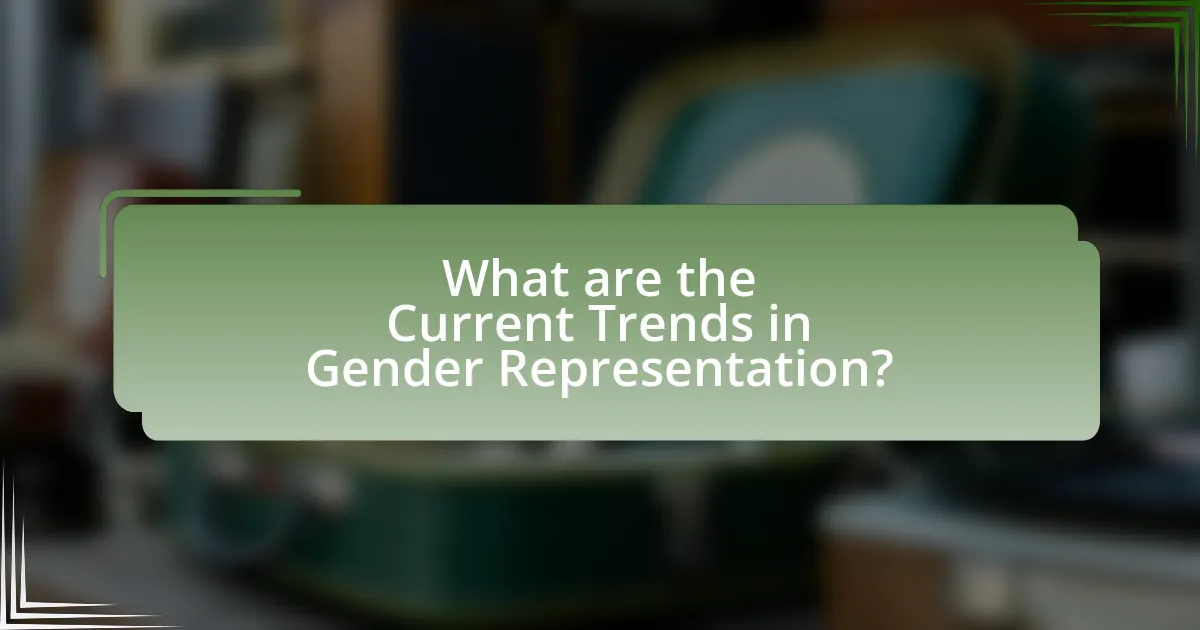
What are the Current Trends in Gender Representation?
Current trends in gender representation in pop and rock music show an increasing visibility of female artists and a shift towards more diverse gender identities. Female musicians are achieving higher chart positions and recognition, with statistics indicating that women comprised 30% of artists on the Billboard Hot 100 in 2022, a notable increase from previous years. Additionally, there is a growing acceptance and representation of non-binary and gender-fluid artists, reflecting broader societal changes in understanding gender. This trend is supported by initiatives like the Women in Music organization, which advocates for gender equality in the music industry, highlighting the ongoing efforts to address historical disparities in representation.
How are female artists represented in pop and rock music today?
Female artists in pop and rock music today are increasingly represented as diverse, empowered figures who challenge traditional gender roles. This shift is evident in the rise of female-led bands and solo artists who dominate charts, such as Billie Eilish and Haim, showcasing a range of musical styles and themes that resonate with contemporary audiences. According to the 2022 report by the Annenberg Inclusion Initiative, women comprised 22.5% of artists on the Billboard Hot 100, indicating a gradual increase in visibility compared to previous years. Furthermore, female artists are often at the forefront of social and political movements, using their platforms to advocate for issues like gender equality and mental health awareness, which reflects a broader cultural acceptance of women’s voices in the music industry.
What roles do female artists play in shaping the music landscape?
Female artists play crucial roles in shaping the music landscape by influencing genres, driving social change, and expanding representation. They have historically contributed to the evolution of various music styles, such as rock, pop, and hip-hop, with artists like Aretha Franklin and Madonna paving the way for future generations. Furthermore, female musicians often address social issues through their lyrics and public personas, as seen with artists like Beyoncé and Taylor Swift, who advocate for gender equality and social justice. Statistics indicate that female artists are increasingly dominating charts; for instance, in 2020, women accounted for 38% of the Billboard Hot 100’s top 10 hits, reflecting their growing impact on mainstream music. This representation not only diversifies the music industry but also inspires young female musicians to pursue their careers, thereby perpetuating a cycle of influence and empowerment.
How do female artists challenge traditional gender norms in their music?
Female artists challenge traditional gender norms in their music by subverting expectations through their lyrics, imagery, and performance styles. For instance, artists like Beyoncé and Lizzo promote messages of empowerment and body positivity, directly confronting societal standards of femininity. Additionally, musicians such as Billie Eilish defy conventional gender roles by embracing androgyny in both their fashion choices and musical themes, which often explore complex emotions and personal struggles. This shift is supported by data showing that female artists are increasingly dominating charts and influencing cultural conversations, as evidenced by the rise of female-led genres like pop and hip-hop, where women assert their autonomy and redefine success on their own terms.
What is the representation of male artists in the context of gender?
The representation of male artists in the context of gender is predominantly characterized by a significant presence and visibility in the music industry. Male artists often dominate charts, award nominations, and festival lineups, reflecting a historical trend where male musicians have been more frequently recognized and promoted compared to their female counterparts. For instance, a study by the Annenberg Inclusion Initiative found that in the top 100 songs from 2012 to 2019, male artists comprised 90.7% of the total artists, highlighting the gender disparity in representation. This dominance is further reinforced by industry practices that favor male-led projects and narratives, contributing to a skewed perception of gender roles within pop and rock music.
How do male artists respond to the changing dynamics of gender representation?
Male artists respond to the changing dynamics of gender representation by increasingly embracing themes of vulnerability and emotional expression in their music. This shift reflects a broader cultural movement towards gender fluidity and the dismantling of traditional masculinity norms. For instance, artists like Harry Styles and Lil Nas X openly challenge gender stereotypes through their fashion choices and lyrical content, promoting inclusivity and self-identity. Research indicates that male artists who adopt these progressive stances often experience greater commercial success and fan engagement, as audiences increasingly value authenticity and representation in the music industry.
What stereotypes persist regarding male artists in pop and rock music?
Stereotypes that persist regarding male artists in pop and rock music include the notions that they are emotionally detached, overly aggressive, and primarily focused on sexual conquests. These stereotypes are reinforced by the portrayal of male artists in media and their lyrics, which often emphasize themes of dominance and machismo. For instance, studies have shown that male musicians frequently adopt personas that align with traditional masculinity, leading to a lack of emotional vulnerability in their public image. Additionally, the prevalence of hyper-masculine imagery in music videos and performances contributes to the stereotype that male artists must conform to aggressive and dominant behaviors to be successful in the industry.
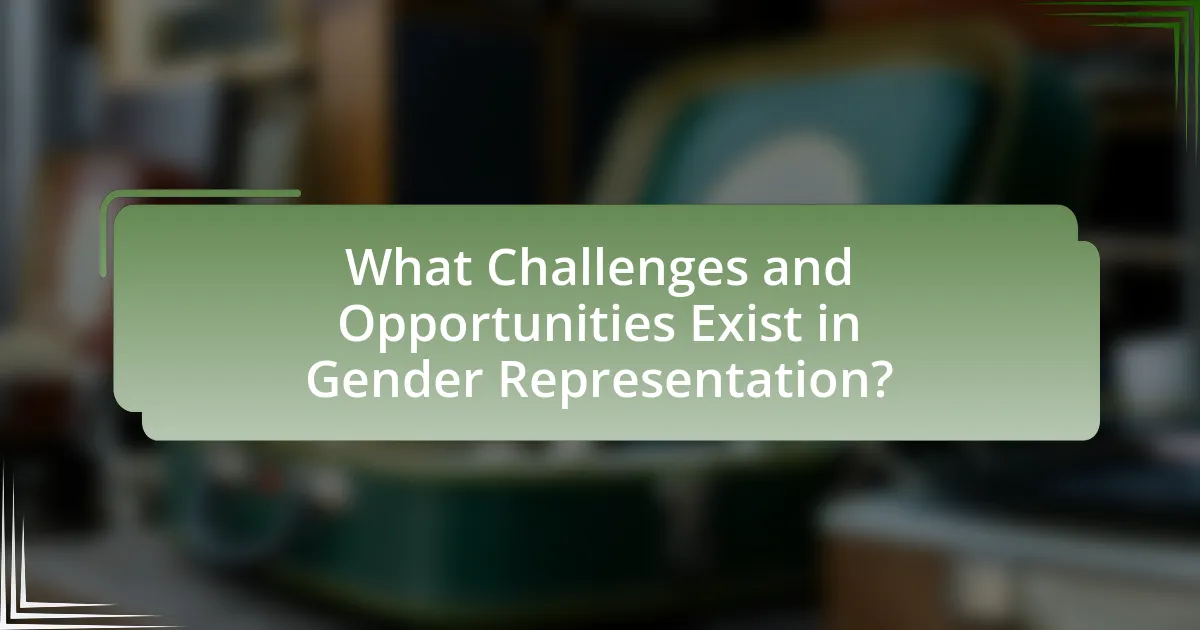
What Challenges and Opportunities Exist in Gender Representation?
Challenges in gender representation in pop and rock music include systemic biases, underrepresentation of female artists, and stereotypes that limit creative expression. For instance, a 2021 study by the Annenberg Inclusion Initiative found that only 22.5% of artists in popular music were women, highlighting significant gender disparity. Opportunities arise from increasing awareness and advocacy for gender equality, leading to initiatives that promote female artists and diverse voices. The rise of social media platforms allows women to gain visibility and build audiences independently, as seen with artists like Billie Eilish and Lizzo, who have leveraged these platforms to challenge traditional industry norms.
What barriers do female artists face in the music industry?
Female artists face significant barriers in the music industry, including gender bias, lack of representation, and unequal access to opportunities. Research indicates that women are underrepresented in key roles such as producers and executives, with only 2% of producers being female according to a 2020 report by the Annenberg Inclusion Initiative. Additionally, female artists often encounter stereotypes that limit their creative expression and marketability, leading to fewer promotional opportunities and lower visibility in mainstream media. These systemic issues contribute to a challenging environment for women seeking to establish and sustain successful careers in music.
How do industry practices affect the visibility of female artists?
Industry practices significantly affect the visibility of female artists by perpetuating gender biases that limit their opportunities for exposure and promotion. For instance, research by the Annenberg Inclusion Initiative found that only 22.4% of artists on the Billboard Hot 100 from 2012 to 2019 were women, indicating a systemic underrepresentation. Additionally, industry practices such as playlist curation, radio airplay, and festival lineups often favor male artists, further marginalizing female talent. This lack of equitable representation in key platforms directly impacts the public’s awareness and appreciation of female artists, reinforcing stereotypes and limiting their career growth.
What initiatives are in place to support gender equality in music?
Initiatives to support gender equality in music include organizations like Women in Music, which advocates for equal opportunities and representation for women in the industry. Additionally, the PRS Foundation’s Keychange initiative commits to achieving a 50/50 gender balance at music festivals and events by 2022, promoting female artists and industry professionals. Furthermore, the Recording Academy has implemented programs aimed at increasing diversity and inclusion within its membership and leadership roles. These initiatives are backed by statistics showing that female representation in music has been historically low, with studies indicating that women make up only about 20% of artists in popular music genres.
How can the music industry improve gender representation?
The music industry can improve gender representation by implementing equitable hiring practices and promoting female artists through targeted marketing and support initiatives. Research indicates that women comprise only 21% of artists in popular music, highlighting a significant gender gap. By establishing mentorship programs and funding opportunities specifically for women, the industry can create pathways for female talent to thrive. Additionally, organizations like the Annenberg Inclusion Initiative have documented that increasing the visibility of women in music leads to greater representation and success, demonstrating that proactive measures can effectively address gender disparities.
What strategies can be implemented to promote diversity in music?
To promote diversity in music, strategies such as inclusive programming, mentorship initiatives, and equitable funding must be implemented. Inclusive programming involves curating music festivals and playlists that feature a diverse range of artists across gender, ethnicity, and genre, ensuring representation in mainstream platforms. Mentorship initiatives can connect emerging artists from underrepresented backgrounds with established musicians, fostering talent development and industry access. Equitable funding ensures that grants and financial support are allocated to diverse artists and projects, addressing historical disparities in the music industry. Research indicates that diverse representation not only enriches the music landscape but also enhances audience engagement and market reach, as seen in the increased popularity of diverse artists in recent years.
How can audiences contribute to better gender representation in music?
Audiences can contribute to better gender representation in music by actively supporting female artists and diverse gender identities through their listening choices and concert attendance. When audiences prioritize music created by women and non-binary artists, they help to shift industry standards and demand more equitable representation. For instance, a study by the Annenberg Inclusion Initiative found that only 22.4% of artists on the Billboard Hot 100 were women from 2012 to 2019, highlighting the need for audience advocacy. By promoting female-led playlists, attending shows featuring women artists, and engaging in discussions about gender equity in music, audiences can influence record labels and streaming platforms to invest in a broader range of talent.
What practical steps can be taken to support gender representation in pop and rock music?
To support gender representation in pop and rock music, industry stakeholders should implement initiatives such as mentorship programs for female artists, equitable hiring practices, and increased funding for women-led projects. Mentorship programs can connect emerging female musicians with established artists, fostering talent development and visibility. Equitable hiring practices, including gender quotas for festival lineups and award nominations, can ensure balanced representation. Additionally, funding initiatives specifically targeting women-led projects can help overcome financial barriers that often hinder female artists. Research indicates that festivals with gender-balanced lineups see increased attendance and diversity, demonstrating the positive impact of these steps on the music industry.
